Accounting Principles: Cost Analysis, Costing & Decision Making
VerifiedAdded on 2023/06/10
|9
|1313
|187
Homework Assignment
AI Summary
This assignment covers several key concepts in accounting, including the high-low method for estimating variable and fixed costs, the preparation of a cost of goods sold schedule and income statement, and relevant cost analysis for make-or-buy decisions. The high-low method is used to determine v...
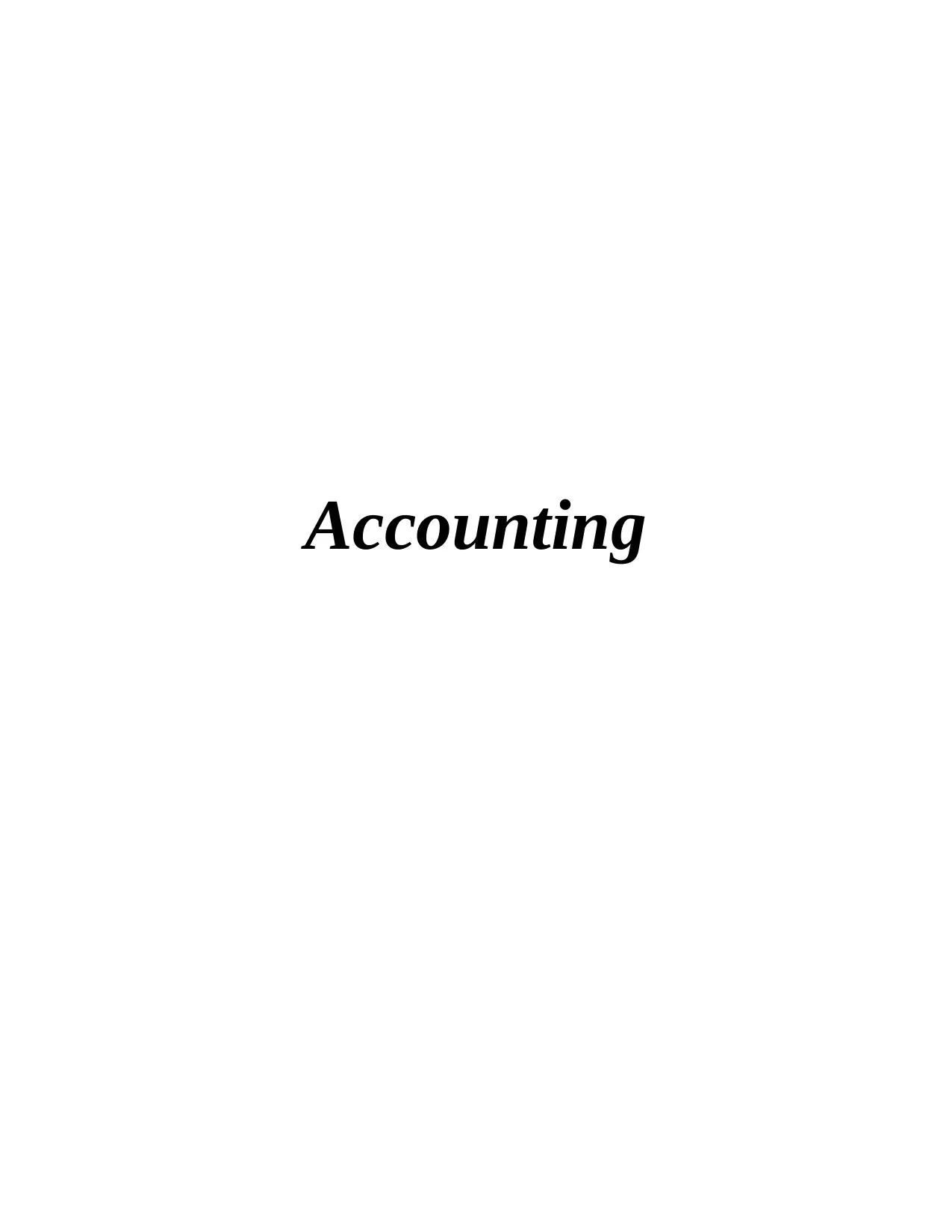
Accounting
Paraphrase This Document
Need a fresh take? Get an instant paraphrase of this document with our AI Paraphraser
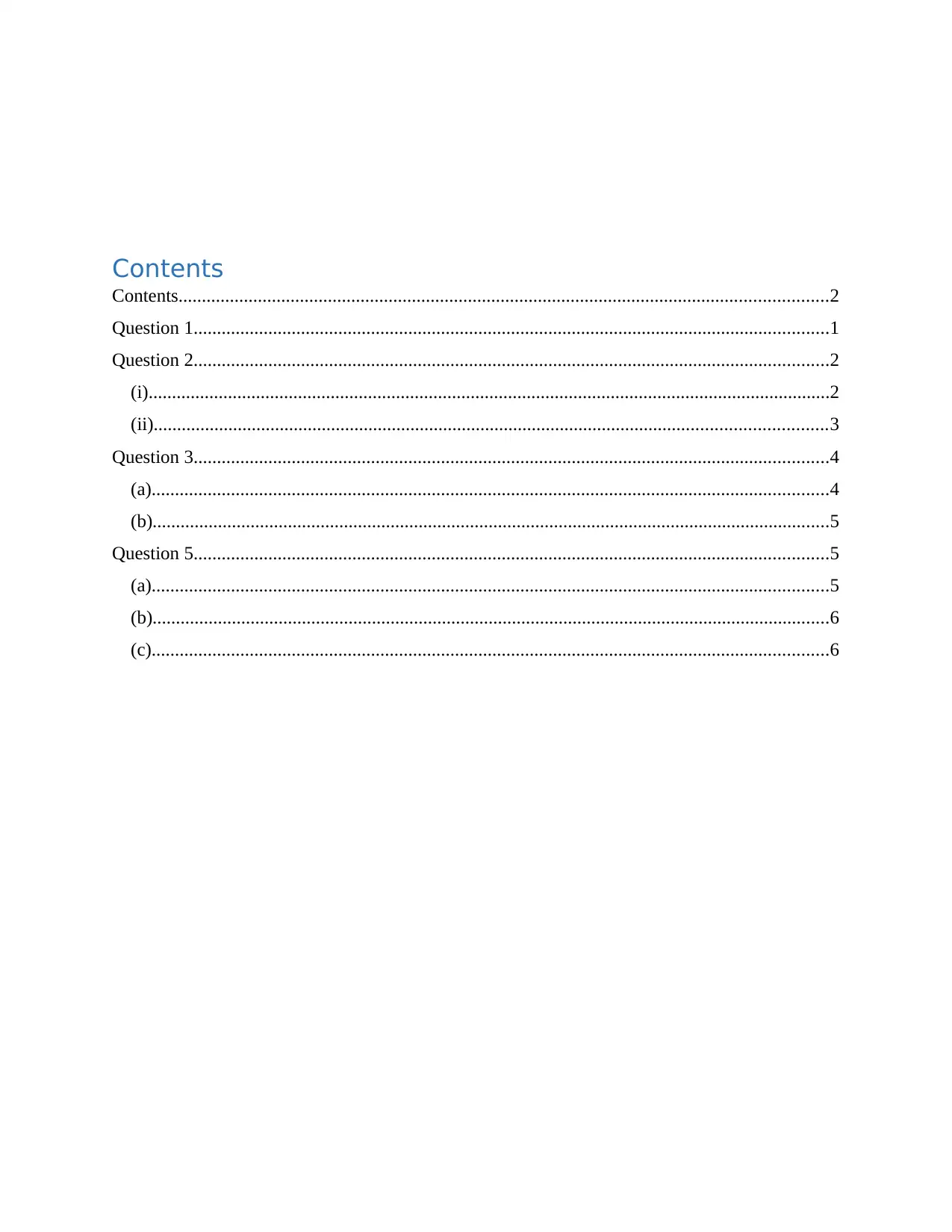
Contents
Contents...........................................................................................................................................2
Question 1........................................................................................................................................1
Question 2........................................................................................................................................2
(i)..................................................................................................................................................2
(ii)................................................................................................................................................3
Question 3........................................................................................................................................4
(a).................................................................................................................................................4
(b).................................................................................................................................................5
Question 5........................................................................................................................................5
(a).................................................................................................................................................5
(b).................................................................................................................................................6
(c).................................................................................................................................................6
Contents...........................................................................................................................................2
Question 1........................................................................................................................................1
Question 2........................................................................................................................................2
(i)..................................................................................................................................................2
(ii)................................................................................................................................................3
Question 3........................................................................................................................................4
(a).................................................................................................................................................4
(b).................................................................................................................................................5
Question 5........................................................................................................................................5
(a).................................................................................................................................................5
(b).................................................................................................................................................6
(c).................................................................................................................................................6
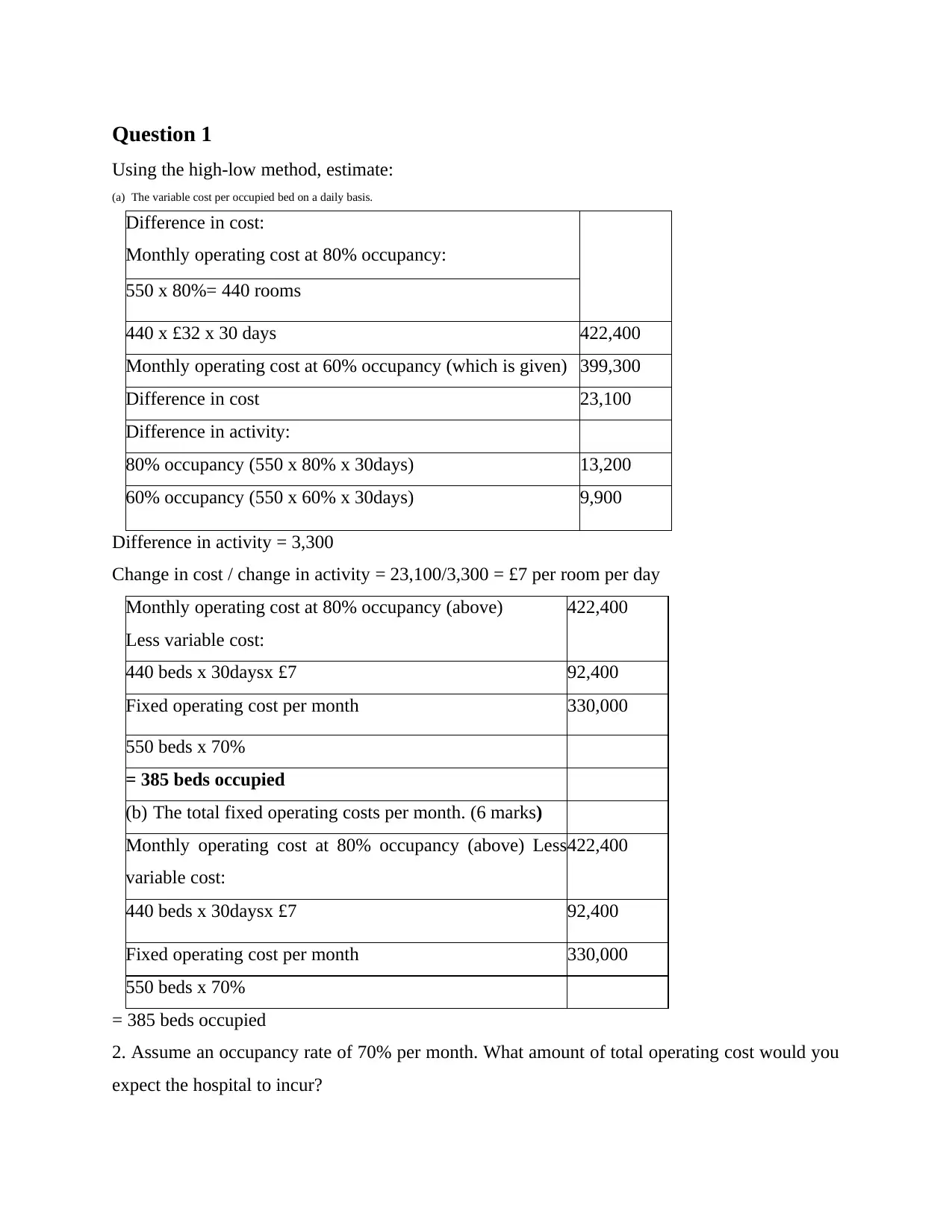
Question 1
Using the high-low method, estimate:
(a) The variable cost per occupied bed on a daily basis.
Difference in cost:
Monthly operating cost at 80% occupancy:
550 x 80%= 440 rooms
440 x £32 x 30 days 422,400
Monthly operating cost at 60% occupancy (which is given) 399,300
Difference in cost 23,100
Difference in activity:
80% occupancy (550 x 80% x 30days) 13,200
60% occupancy (550 x 60% x 30days) 9,900
Difference in activity = 3,300
Change in cost / change in activity = 23,100/3,300 = £7 per room per day
Monthly operating cost at 80% occupancy (above)
Less variable cost:
422,400
440 beds x 30daysx £7 92,400
Fixed operating cost per month 330,000
550 beds x 70%
= 385 beds occupied
(b) The total fixed operating costs per month. (6 marks)
Monthly operating cost at 80% occupancy (above) Less
variable cost:
422,400
440 beds x 30daysx £7 92,400
Fixed operating cost per month 330,000
550 beds x 70%
= 385 beds occupied
2. Assume an occupancy rate of 70% per month. What amount of total operating cost would you
expect the hospital to incur?
Using the high-low method, estimate:
(a) The variable cost per occupied bed on a daily basis.
Difference in cost:
Monthly operating cost at 80% occupancy:
550 x 80%= 440 rooms
440 x £32 x 30 days 422,400
Monthly operating cost at 60% occupancy (which is given) 399,300
Difference in cost 23,100
Difference in activity:
80% occupancy (550 x 80% x 30days) 13,200
60% occupancy (550 x 60% x 30days) 9,900
Difference in activity = 3,300
Change in cost / change in activity = 23,100/3,300 = £7 per room per day
Monthly operating cost at 80% occupancy (above)
Less variable cost:
422,400
440 beds x 30daysx £7 92,400
Fixed operating cost per month 330,000
550 beds x 70%
= 385 beds occupied
(b) The total fixed operating costs per month. (6 marks)
Monthly operating cost at 80% occupancy (above) Less
variable cost:
422,400
440 beds x 30daysx £7 92,400
Fixed operating cost per month 330,000
550 beds x 70%
= 385 beds occupied
2. Assume an occupancy rate of 70% per month. What amount of total operating cost would you
expect the hospital to incur?
You're viewing a preview
Unlock full access by subscribing today!
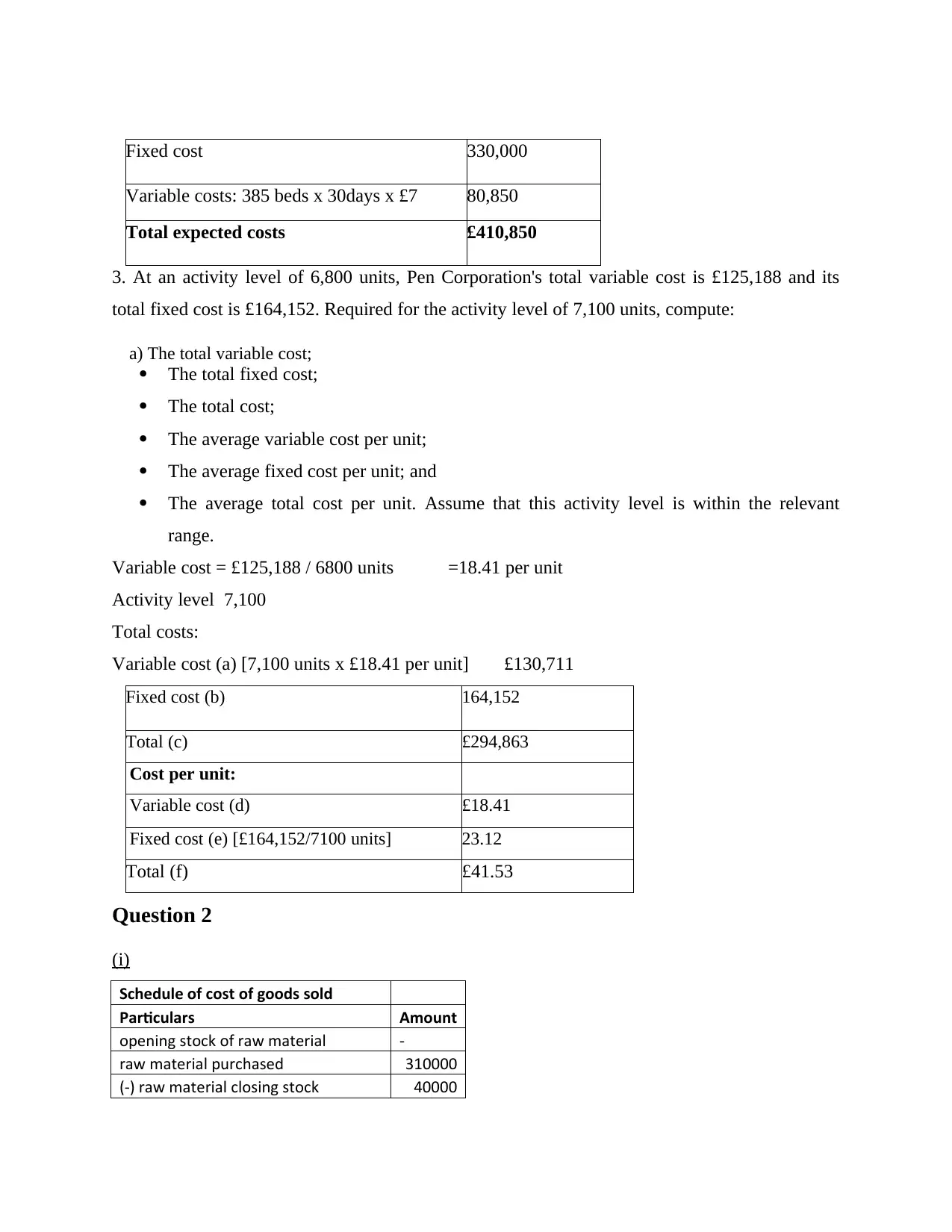
Fixed cost 330,000
Variable costs: 385 beds x 30days x £7 80,850
Total expected costs £410,850
3. At an activity level of 6,800 units, Pen Corporation's total variable cost is £125,188 and its
total fixed cost is £164,152. Required for the activity level of 7,100 units, compute:
a) The total variable cost;
The total fixed cost;
The total cost;
The average variable cost per unit;
The average fixed cost per unit; and
The average total cost per unit. Assume that this activity level is within the relevant
range.
Variable cost = £125,188 / 6800 units =18.41 per unit
Activity level 7,100
Total costs:
Variable cost (a) [7,100 units x £18.41 per unit] £130,711
Fixed cost (b) 164,152
Total (c) £294,863
Cost per unit:
Variable cost (d) £18.41
Fixed cost (e) [£164,152/7100 units] 23.12
Total (f) £41.53
Question 2
(i)
Schedule of cost of goods sold
Particulars Amount
opening stock of raw material -
raw material purchased 310000
(-) raw material closing stock 40000
Variable costs: 385 beds x 30days x £7 80,850
Total expected costs £410,850
3. At an activity level of 6,800 units, Pen Corporation's total variable cost is £125,188 and its
total fixed cost is £164,152. Required for the activity level of 7,100 units, compute:
a) The total variable cost;
The total fixed cost;
The total cost;
The average variable cost per unit;
The average fixed cost per unit; and
The average total cost per unit. Assume that this activity level is within the relevant
range.
Variable cost = £125,188 / 6800 units =18.41 per unit
Activity level 7,100
Total costs:
Variable cost (a) [7,100 units x £18.41 per unit] £130,711
Fixed cost (b) 164,152
Total (c) £294,863
Cost per unit:
Variable cost (d) £18.41
Fixed cost (e) [£164,152/7100 units] 23.12
Total (f) £41.53
Question 2
(i)
Schedule of cost of goods sold
Particulars Amount
opening stock of raw material -
raw material purchased 310000
(-) raw material closing stock 40000
Paraphrase This Document
Need a fresh take? Get an instant paraphrase of this document with our AI Paraphraser
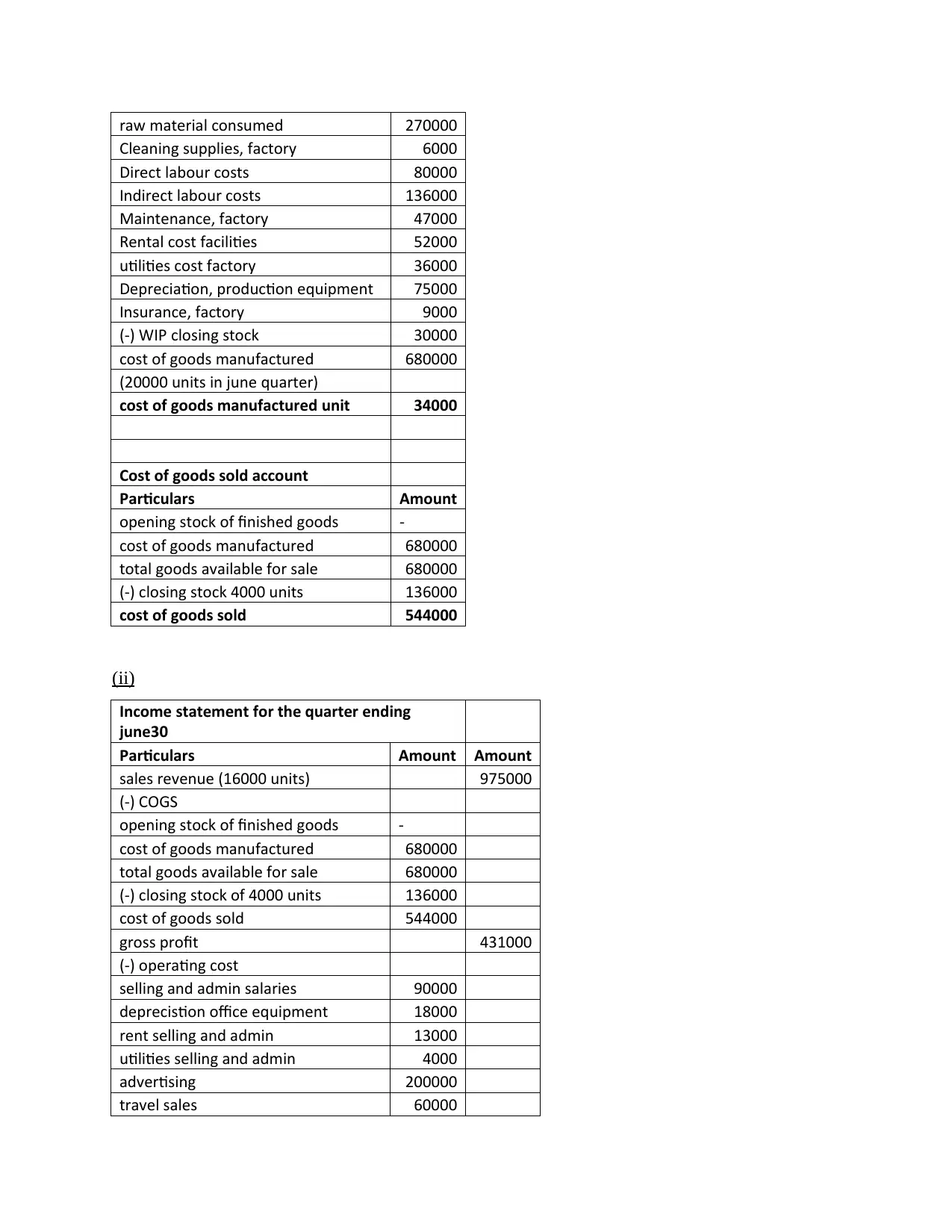
raw material consumed 270000
Cleaning supplies, factory 6000
Direct labour costs 80000
Indirect labour costs 136000
Maintenance, factory 47000
Rental cost facilities 52000
utilities cost factory 36000
Depreciation, production equipment 75000
Insurance, factory 9000
(-) WIP closing stock 30000
cost of goods manufactured 680000
(20000 units in june quarter)
cost of goods manufactured unit 34000
Cost of goods sold account
Particulars Amount
opening stock of finished goods -
cost of goods manufactured 680000
total goods available for sale 680000
(-) closing stock 4000 units 136000
cost of goods sold 544000
(ii)
Income statement for the quarter ending
june30
Particulars Amount Amount
sales revenue (16000 units) 975000
(-) COGS
opening stock of finished goods -
cost of goods manufactured 680000
total goods available for sale 680000
(-) closing stock of 4000 units 136000
cost of goods sold 544000
gross profit 431000
(-) operating cost
selling and admin salaries 90000
deprecistion office equipment 18000
rent selling and admin 13000
utilities selling and admin 4000
advertising 200000
travel sales 60000
Cleaning supplies, factory 6000
Direct labour costs 80000
Indirect labour costs 136000
Maintenance, factory 47000
Rental cost facilities 52000
utilities cost factory 36000
Depreciation, production equipment 75000
Insurance, factory 9000
(-) WIP closing stock 30000
cost of goods manufactured 680000
(20000 units in june quarter)
cost of goods manufactured unit 34000
Cost of goods sold account
Particulars Amount
opening stock of finished goods -
cost of goods manufactured 680000
total goods available for sale 680000
(-) closing stock 4000 units 136000
cost of goods sold 544000
(ii)
Income statement for the quarter ending
june30
Particulars Amount Amount
sales revenue (16000 units) 975000
(-) COGS
opening stock of finished goods -
cost of goods manufactured 680000
total goods available for sale 680000
(-) closing stock of 4000 units 136000
cost of goods sold 544000
gross profit 431000
(-) operating cost
selling and admin salaries 90000
deprecistion office equipment 18000
rent selling and admin 13000
utilities selling and admin 4000
advertising 200000
travel sales 60000
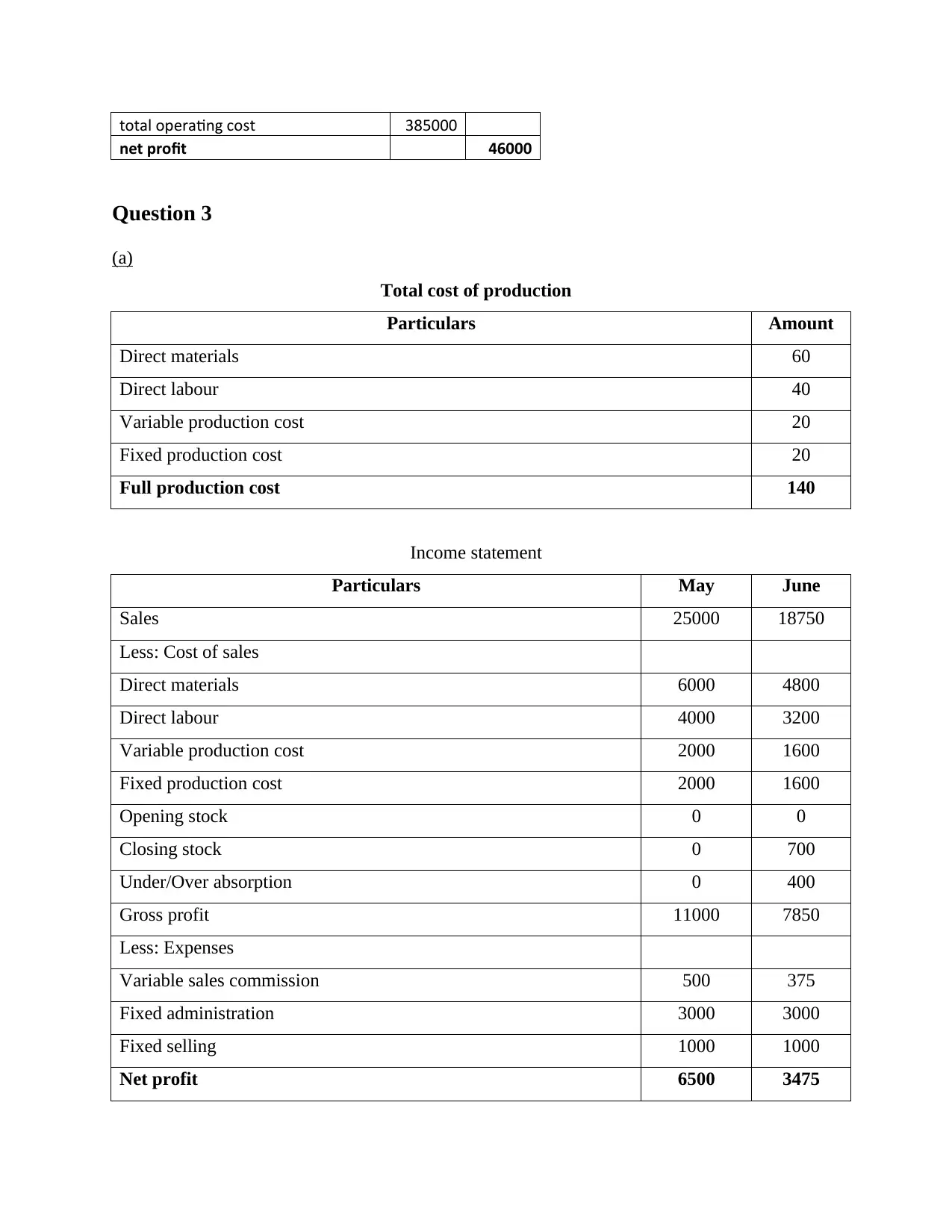
total operating cost 385000
net profit 46000
Question 3
(a)
Total cost of production
Particulars Amount
Direct materials 60
Direct labour 40
Variable production cost 20
Fixed production cost 20
Full production cost 140
Income statement
Particulars May June
Sales 25000 18750
Less: Cost of sales
Direct materials 6000 4800
Direct labour 4000 3200
Variable production cost 2000 1600
Fixed production cost 2000 1600
Opening stock 0 0
Closing stock 0 700
Under/Over absorption 0 400
Gross profit 11000 7850
Less: Expenses
Variable sales commission 500 375
Fixed administration 3000 3000
Fixed selling 1000 1000
Net profit 6500 3475
net profit 46000
Question 3
(a)
Total cost of production
Particulars Amount
Direct materials 60
Direct labour 40
Variable production cost 20
Fixed production cost 20
Full production cost 140
Income statement
Particulars May June
Sales 25000 18750
Less: Cost of sales
Direct materials 6000 4800
Direct labour 4000 3200
Variable production cost 2000 1600
Fixed production cost 2000 1600
Opening stock 0 0
Closing stock 0 700
Under/Over absorption 0 400
Gross profit 11000 7850
Less: Expenses
Variable sales commission 500 375
Fixed administration 3000 3000
Fixed selling 1000 1000
Net profit 6500 3475
You're viewing a preview
Unlock full access by subscribing today!
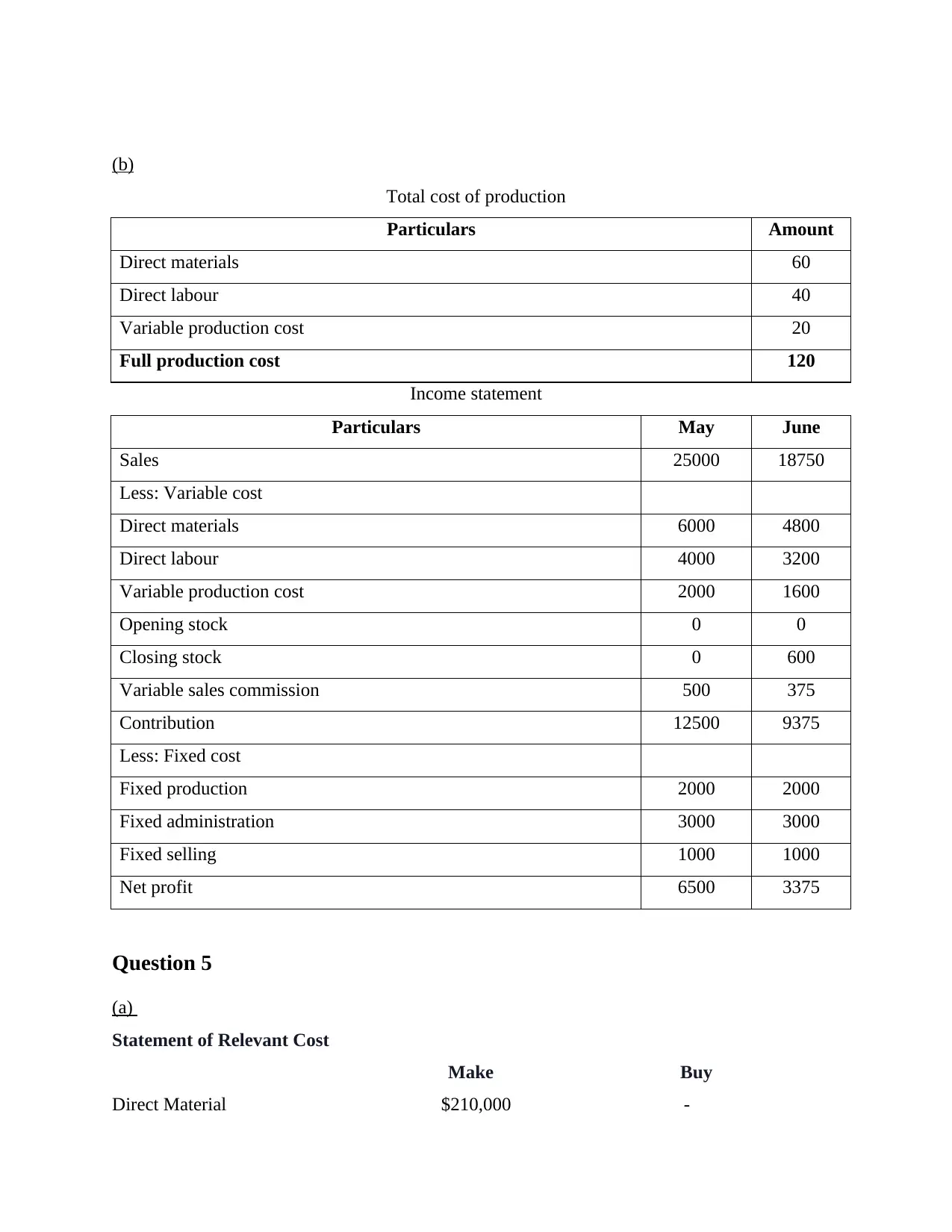
(b)
Total cost of production
Particulars Amount
Direct materials 60
Direct labour 40
Variable production cost 20
Full production cost 120
Income statement
Particulars May June
Sales 25000 18750
Less: Variable cost
Direct materials 6000 4800
Direct labour 4000 3200
Variable production cost 2000 1600
Opening stock 0 0
Closing stock 0 600
Variable sales commission 500 375
Contribution 12500 9375
Less: Fixed cost
Fixed production 2000 2000
Fixed administration 3000 3000
Fixed selling 1000 1000
Net profit 6500 3375
Question 5
(a)
Statement of Relevant Cost
Make Buy
Direct Material $210,000 -
Total cost of production
Particulars Amount
Direct materials 60
Direct labour 40
Variable production cost 20
Full production cost 120
Income statement
Particulars May June
Sales 25000 18750
Less: Variable cost
Direct materials 6000 4800
Direct labour 4000 3200
Variable production cost 2000 1600
Opening stock 0 0
Closing stock 0 600
Variable sales commission 500 375
Contribution 12500 9375
Less: Fixed cost
Fixed production 2000 2000
Fixed administration 3000 3000
Fixed selling 1000 1000
Net profit 6500 3375
Question 5
(a)
Statement of Relevant Cost
Make Buy
Direct Material $210,000 -
Paraphrase This Document
Need a fresh take? Get an instant paraphrase of this document with our AI Paraphraser
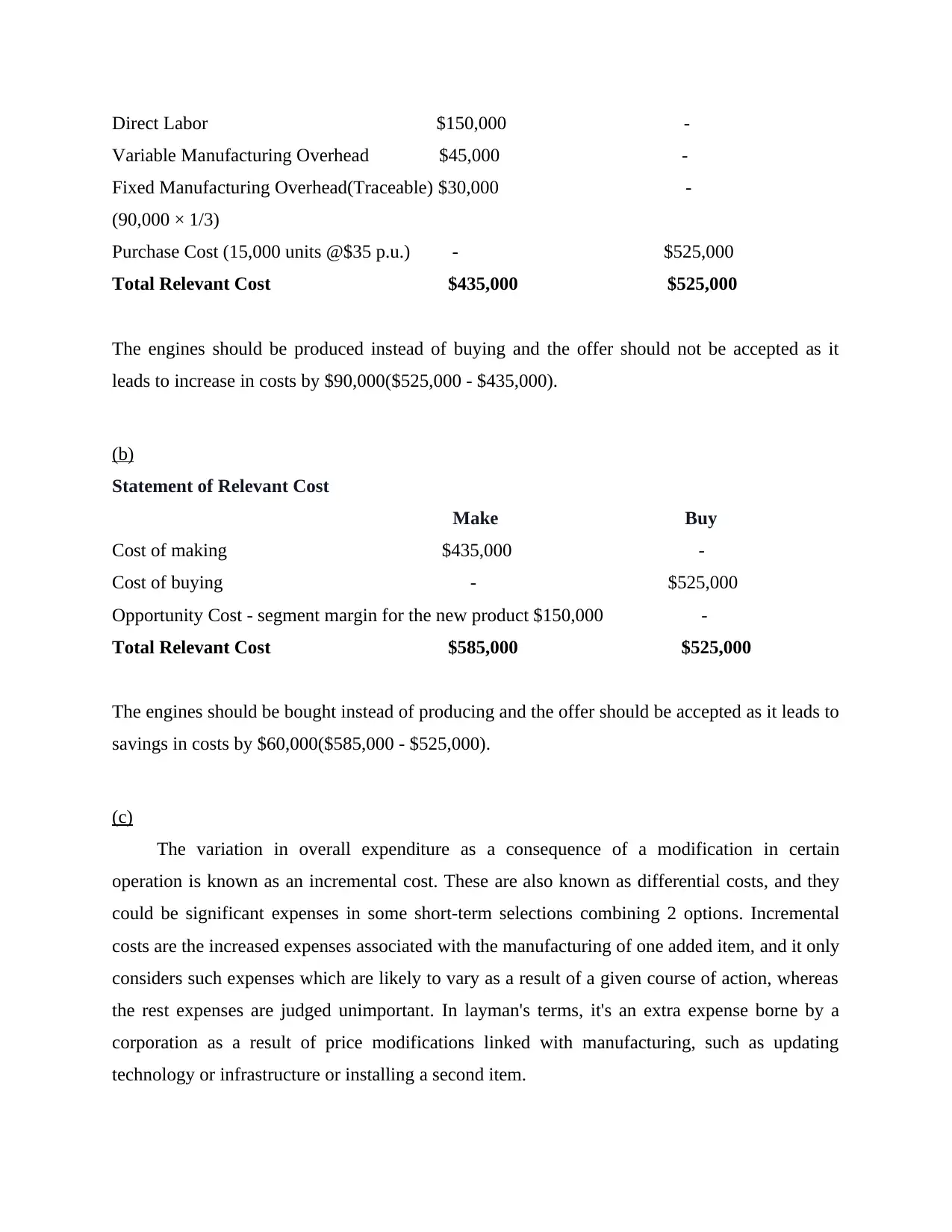
Direct Labor $150,000 -
Variable Manufacturing Overhead $45,000 -
Fixed Manufacturing Overhead(Traceable) $30,000 -
(90,000 × 1/3)
Purchase Cost (15,000 units @$35 p.u.) - $525,000
Total Relevant Cost $435,000 $525,000
The engines should be produced instead of buying and the offer should not be accepted as it
leads to increase in costs by $90,000($525,000 - $435,000).
(b)
Statement of Relevant Cost
Make Buy
Cost of making $435,000 -
Cost of buying - $525,000
Opportunity Cost - segment margin for the new product $150,000 -
Total Relevant Cost $585,000 $525,000
The engines should be bought instead of producing and the offer should be accepted as it leads to
savings in costs by $60,000($585,000 - $525,000).
(c)
The variation in overall expenditure as a consequence of a modification in certain
operation is known as an incremental cost. These are also known as differential costs, and they
could be significant expenses in some short-term selections combining 2 options. Incremental
costs are the increased expenses associated with the manufacturing of one added item, and it only
considers such expenses which are likely to vary as a result of a given course of action, whereas
the rest expenses are judged unimportant. In layman's terms, it's an extra expense borne by a
corporation as a result of price modifications linked with manufacturing, such as updating
technology or infrastructure or installing a second item.
Variable Manufacturing Overhead $45,000 -
Fixed Manufacturing Overhead(Traceable) $30,000 -
(90,000 × 1/3)
Purchase Cost (15,000 units @$35 p.u.) - $525,000
Total Relevant Cost $435,000 $525,000
The engines should be produced instead of buying and the offer should not be accepted as it
leads to increase in costs by $90,000($525,000 - $435,000).
(b)
Statement of Relevant Cost
Make Buy
Cost of making $435,000 -
Cost of buying - $525,000
Opportunity Cost - segment margin for the new product $150,000 -
Total Relevant Cost $585,000 $525,000
The engines should be bought instead of producing and the offer should be accepted as it leads to
savings in costs by $60,000($585,000 - $525,000).
(c)
The variation in overall expenditure as a consequence of a modification in certain
operation is known as an incremental cost. These are also known as differential costs, and they
could be significant expenses in some short-term selections combining 2 options. Incremental
costs are the increased expenses associated with the manufacturing of one added item, and it only
considers such expenses which are likely to vary as a result of a given course of action, whereas
the rest expenses are judged unimportant. In layman's terms, it's an extra expense borne by a
corporation as a result of price modifications linked with manufacturing, such as updating
technology or infrastructure or installing a second item.
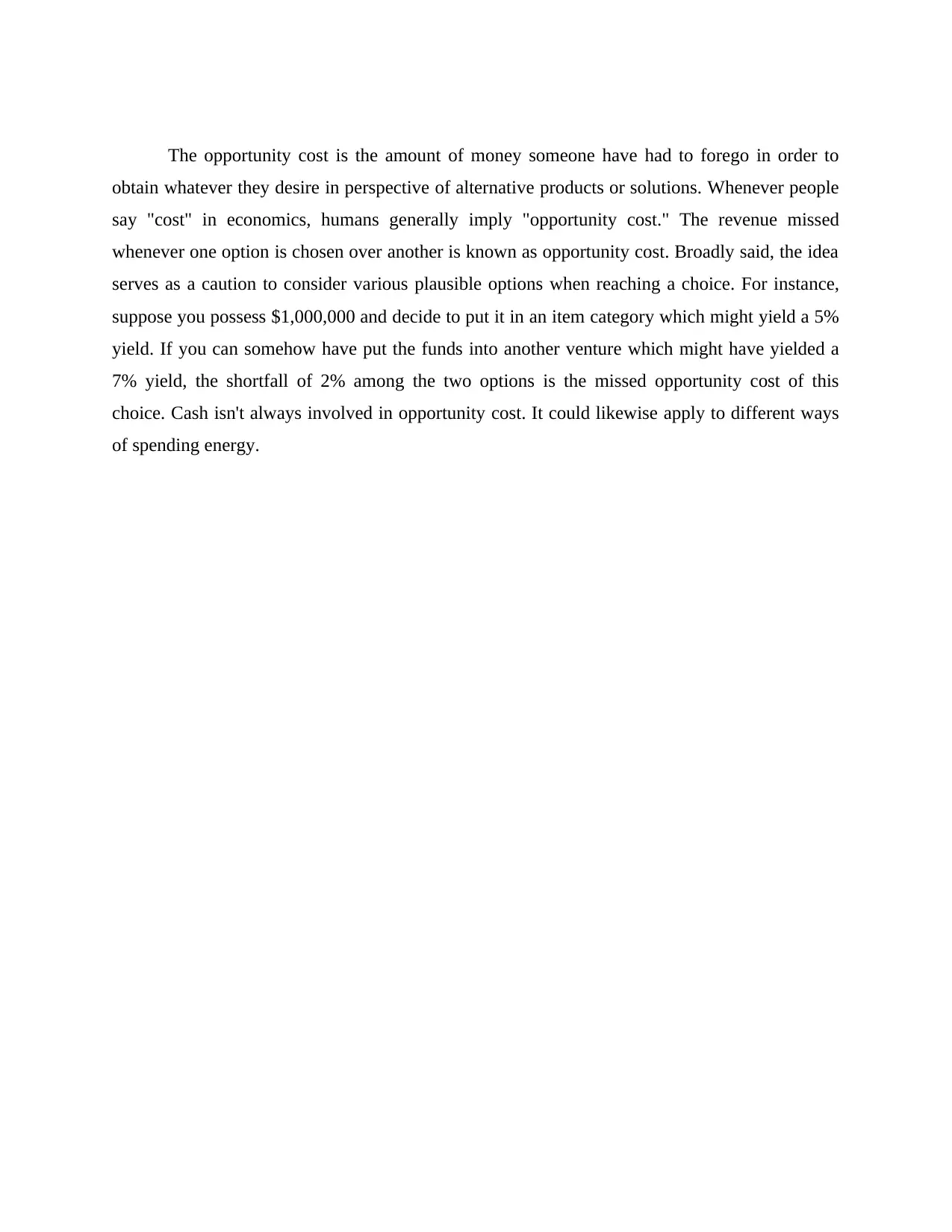
The opportunity cost is the amount of money someone have had to forego in order to
obtain whatever they desire in perspective of alternative products or solutions. Whenever people
say "cost" in economics, humans generally imply "opportunity cost." The revenue missed
whenever one option is chosen over another is known as opportunity cost. Broadly said, the idea
serves as a caution to consider various plausible options when reaching a choice. For instance,
suppose you possess $1,000,000 and decide to put it in an item category which might yield a 5%
yield. If you can somehow have put the funds into another venture which might have yielded a
7% yield, the shortfall of 2% among the two options is the missed opportunity cost of this
choice. Cash isn't always involved in opportunity cost. It could likewise apply to different ways
of spending energy.
obtain whatever they desire in perspective of alternative products or solutions. Whenever people
say "cost" in economics, humans generally imply "opportunity cost." The revenue missed
whenever one option is chosen over another is known as opportunity cost. Broadly said, the idea
serves as a caution to consider various plausible options when reaching a choice. For instance,
suppose you possess $1,000,000 and decide to put it in an item category which might yield a 5%
yield. If you can somehow have put the funds into another venture which might have yielded a
7% yield, the shortfall of 2% among the two options is the missed opportunity cost of this
choice. Cash isn't always involved in opportunity cost. It could likewise apply to different ways
of spending energy.
You're viewing a preview
Unlock full access by subscribing today!
1 out of 9
Related Documents
Your All-in-One AI-Powered Toolkit for Academic Success.
+13062052269
info@desklib.com
Available 24*7 on WhatsApp / Email
![[object Object]](/_next/static/media/star-bottom.7253800d.svg)
Unlock your academic potential
© 2024 | Zucol Services PVT LTD | All rights reserved.




